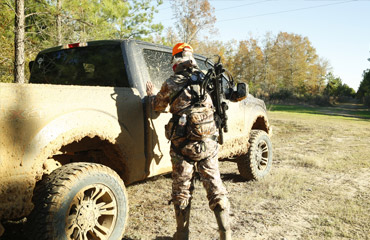There are lots of variables when it comes to toting your crossbow afield while hunting, but safety should always be a priority. Let’s consider a couple scenarios that crossbows users encounter regularly.
If you’re on the way to your deer stand in the predawn, your crossbow should be uncocked and unloaded, and a smart addition is a sling that will help you handle the load without bumbling and stumbling. A good sling can be a crossbow’s hunter’s best friend.
Crossbows can be awkward to carry, so you might even want to check out a product called Bow Spider (bowspider.com). It’s a lightweight attachment system for crossbows (or compounds) that allows for easily accessible attachment of bows to a variety of sources, including backpacks or fanny packs, for hands-free carry.
But let’s say you’re hiking to a stand in daylight, it’s the peak of the rut and there’s a good chance you could run into a rutting buck on the way in to your stand. Actually, during the rut, if you’re the type of person who finds it hard to sit still in a stand all day, it can be a smart play to forgo those early predawn hike-ins in favor of a late-morning start. If you leave about 8:00 to 8:30 or so, you will soon be in position — and well rested and alert — to take advantage of classic rutting buck daylight movement that typically occurs between about 10 a.m. and 2 p.m.
So in a case like this, it’s a smart play to cock your bow at your vehicle and cradle the unloaded crossbow in your arms as you slowly stalk to your stand. If you hear chasing, or a buck suddenly appears trailing a doe, you’ll be ready. Then, it’s a simple matter to reach into your quiver, and load an arrow for a potential shot. And instead of mourning a lost opportunity, you just might be prepping for a memorable success photo.




.png)